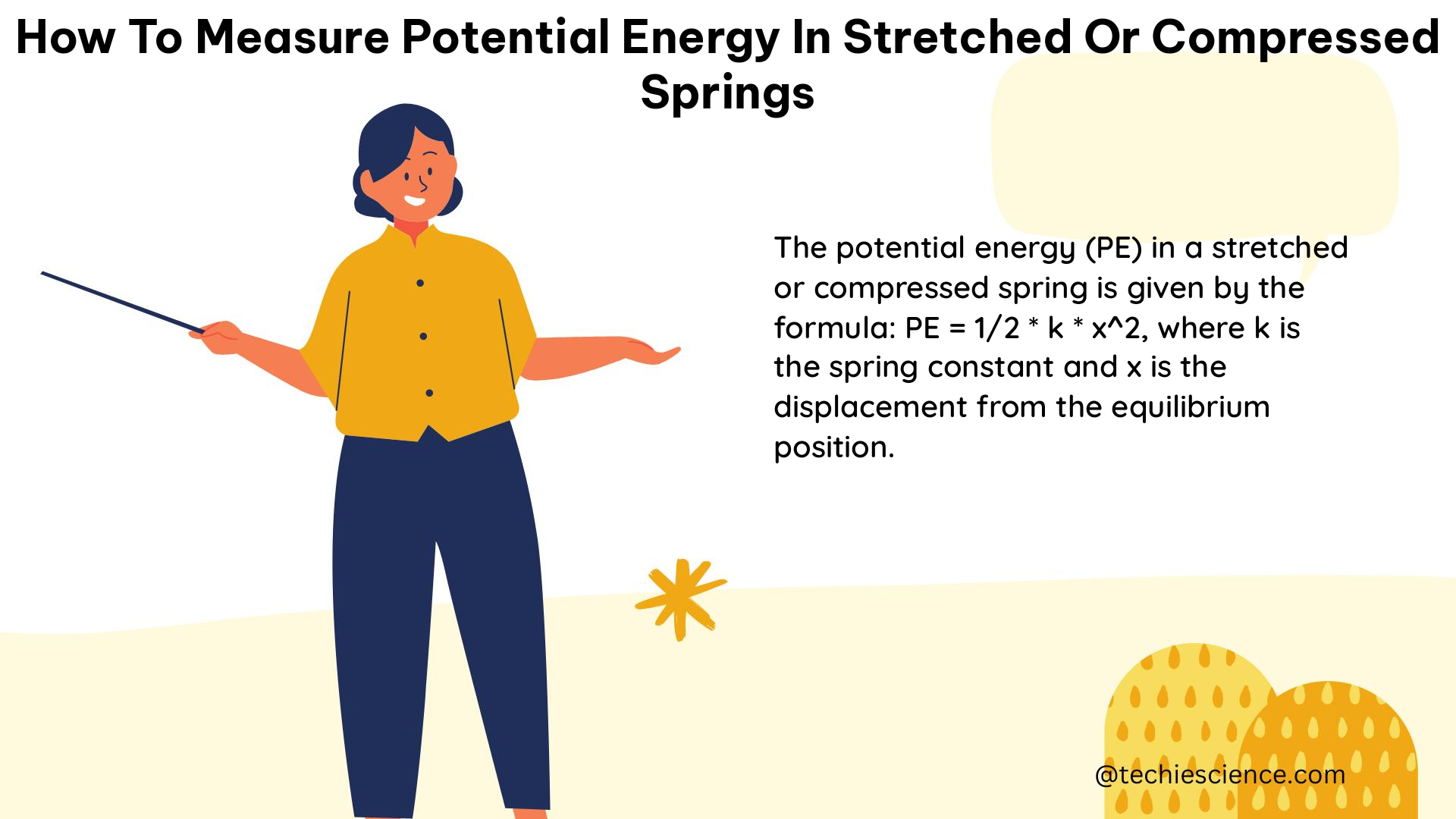Measuring the potential energy stored in a stretched or compressed spring is a fundamental concept in physics. This comprehensive guide will walk you through the step-by-step process, including the necessary formulas, examples, and key points to help you master this topic.
Step 1: Determine the Spring Constant (k)
The spring constant, denoted as k, is a measure of the spring’s stiffness. It can be calculated using Hooke’s Law, which states that the force (F) required to stretch or compress a spring is directly proportional to the displacement (x) from its natural length:
F = kx
To find the spring constant, you can rearrange the equation:
k = F/x
Here’s an example:
Suppose a spring has a natural length of 40 cm and requires a force of 240 N to stretch it to a length of 60 cm. What is the spring constant?
Given:
– Natural length of the spring = 40 cm
– Force required to stretch the spring = 240 N
– Stretched length of the spring = 60 cm
Step 1: Calculate the displacement (x)
Displacement (x) = Stretched length – Natural length
Displacement (x) = 60 cm – 40 cm = 20 cm = 0.20 m
Step 2: Calculate the spring constant (k)
Spring constant (k) = Force (F) / Displacement (x)
Spring constant (k) = 240 N / 0.20 m = 1200 N/m
Therefore, the spring constant (k) is 1200 N/m.
Step 2: Calculate the Displacement (x)

To calculate the potential energy stored in a stretched or compressed spring, you need to know the displacement (x) of the spring from its natural length. This can be done by measuring the length of the spring before and after stretching or compressing it.
For example, if the natural length of the spring is 40 cm and the stretched length is 70 cm, the displacement (x) would be:
x = Stretched length - Natural length
x = 70 cm - 40 cm = 30 cm = 0.30 m
Step 3: Calculate the Elastic Potential Energy (PE)
The elastic potential energy (PE) stored in a stretched or compressed spring is given by the formula:
PE = (1/2) * k * x^2
Where:
– PE is the elastic potential energy (in Joules)
– k is the spring constant (in N/m)
– x is the displacement (in meters)
Let’s continue the example from the previous step:
Given:
– Spring constant (k) = 1200 N/m
– Displacement (x) = 0.30 m
Calculating the elastic potential energy (PE):
PE = (1/2) * k * x^2
PE = (1/2) * 1200 N/m * (0.30 m)^2
PE = 54 J
Therefore, the elastic potential energy stored in the spring when it is stretched to 70 cm is 54 Joules.
Example 2: Calculating Displacement from Elastic Potential Energy
In some cases, you may know the elastic potential energy (PE) stored in a spring and the spring constant (k), and you need to find the displacement (x).
For example, suppose a compressed spring has a potential energy of 20 J, and its spring constant is 200 N/m. What is the displacement of the spring?
Given:
– Elastic potential energy (PE) = 20 J
– Spring constant (k) = 200 N/m
We can use the formula for elastic potential energy to solve for the displacement (x):
PE = (1/2) * k * x^2
x = √(2 * PE / k)
x = √(2 * 20 J / 200 N/m)
x = 0.632 m
Therefore, the displacement of the compressed spring is 0.632 meters.
Key Formulas and Points
- Hooke’s Law:
F = kx - Elastic Potential Energy:
PE = (1/2) * k * x^2 - Spring Constant:
k = F/x - Displacement:
x = √(2 * PE / k)
Remember, these formulas and concepts are essential for understanding and calculating the potential energy stored in stretched or compressed springs. Make sure to practice with various examples and numerical problems to solidify your understanding.
Additional Resources
- Wyzant. (2021, November 9). Calculate the elastic potential energy stored in the spring. Retrieved from https://www.wyzant.com/resources/answers/874209/calculate-the-elastic-potential-energy-stored-in-the-spring
- HyperPhysics. (n.d.). Elastic Potential Energy. Retrieved from http://hyperphysics.phy-astr.gsu.edu/hbase/pespr.html
- BYJU’S. (n.d.). Elastic Potential Energy Formula with Examples. Retrieved from https://byjus.com/elastic-potential-energy-formula/
- Khan Academy. (n.d.). Spring potential energy and Hooke’s law review. Retrieved from https://www.khanacademy.org/science/hs-physics/x215e29cb31244fa1:modeling-energy/x215e29cb31244fa1:calculating-energy/a/spring-force-and-energy-ap1
- Physics Stack Exchange. (2020, August 29). Spring potential energy (where to measure it from and why). Retrieved from https://physics.stackexchange.com/questions/576378/spring-potential-energy-where-to-measure-it-from-and-why

The lambdageeks.com Core SME Team is a group of experienced subject matter experts from diverse scientific and technical fields including Physics, Chemistry, Technology,Electronics & Electrical Engineering, Automotive, Mechanical Engineering. Our team collaborates to create high-quality, well-researched articles on a wide range of science and technology topics for the lambdageeks.com website.
All Our Senior SME are having more than 7 Years of experience in the respective fields . They are either Working Industry Professionals or assocaited With different Universities. Refer Our Authors Page to get to know About our Core SMEs.